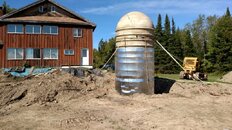Hi Joe
So I am not here to judge you or lecture you. I will provide some Facts which you may utilize as you see fit.
The first two and most important facts to consider involve the physiology of oxygen exposure while diving. The first of these is that there is a considerable difference in response to hyperbaric oxygen while wet than while in a chamber. The reasons for this are poorly understood but may be related to the mammalian diving reflex. In very broad terms the likelihood of adverse reactions to hyperbaric oxygen are greater while submerged than while dry. The second fact of importance is that adverse reactions to oxygen while diving are frequently fatal, because they involve convulsions, which can lead to inhalation of water as well as precluding effective self-rescue.
In non-emergency situations the customary limit for technical divers during decompression stops where there is no movement or activity to exacerbate the risks is a partial pressure of 1.6 atmospheres. For divers who lack training in decompression procedures, or for technical divers during non-decompression portions of the dive, the usual limit is 1.4 atmospheres with some training agencies recommending a more conservative limit of 1.3 atmospheres. There are time limits that apply at these outer limits of exposure.
For divers without technical training and equipment, the richest oxygen concentration that is considered suitable is 40% O2 (EAN40). Dive shops that offer nitrox blending will typically not blend above 40% for a customer who lacks the training and experience to handle the hazards of such a mix. This is also true for 100% oxygen fills into scuba cylinders.
The training required to perform dives with richer mixtures is demanding and typically only offered to accomplished divers who have already developed their skills throughout a year or more of frequent diving. The exact course names and requirements vary among agencies however you may wish to look at the TDI Advanced Nitrox class or the PADI Tech 45 course for an idea of what is usually required.
Returning to EAN40 dives, with a cylinder of EAN40 you would reach a partial pressure of 1.0 atmospheres at a depth of approximately 50 feet and would have to dive somewhat deeper for the partial pressure to be hyperbaric, with a partial pressure of 1.4 atmospheres (for example) being reached at 82 feet. A question to consider is whether you have ready access to dive sites of this depth.
If you were to obtain 100% oxygen fills, the first question to consider would be whether your equipment is suited for oxygen service. While there are exceptions, most regulators and most cylinders are not suitable for oxygen service when sold, and second hand gear of unknown provenance cannot be considered oxygen safe at the time of purchase even if it was manufactured for such service. Typically it is possible to prepare a cylinder, valve, and regulator set for oxygen service through scrupulous cleaning and upgrading of certain critical parts, but doing so is a job for an experienced technician and may not be possible for some gear. The second question to consider would be training, since even if you were able to obtain fills, the hazards of diving on 100% oxygen are great, particularly for inexperienced divers whose buoyancy control is questionable, or whose mastery of emergency procedures is in doubt.
As one example, I have not and do not dive mixes over EAN40 despite having 100% oxygen readily available to me; while relatively new to diving I have made perhaps 125 dives over the last year or two, and have not taken any technical training. Nor have I or do I exceed an oxygen partial pressure of 1.4 atmospheres.
Best wishes however you decide to proceed.





